Effect of Sodium Gluconate on Properties and Microstructure of Ultra-High-Performance Concrete (UHPC)
Abstract
1. Introduction
2. Research Significance
3. Experiments
3.1. Raw Materials
3.2. Mix Proportion of UHPC
3.3. Test Methods
3.3.1. Fluidity and Setting Time
3.3.2. Heat of Hydration
3.3.3. Mechanical Properties
3.3.4. Microscopic Testing
4. Results and Discussion
4.1. Effect of SG on Fluidity in the Plastic Stage of UHPC
4.1.1. UHPC Fluidity Test Results
4.1.2. XRD Analysis of Hydration Products in the Plastic Stage
4.2. Effect of SG on UHPC Setting and Hardening Process
4.2.1. Effect of SG on UHPC Setting Time
4.2.2. Effect of SG on UHPC Heat of Hydration
4.2.3. Setting and Hardening Stage XRD and SEM Test Results
4.3. Effect of SG on UHPC Strength Development and Pore Structure
4.3.1. Effect of SG on Compressive Strength of UHPC
4.3.2. XRD Test Results at Different Ages
4.3.3. SEM Test Results at Different Ages
4.4. Discussion
4.4.1. Analysis of the Influence of SG on the Whole Process of Cement Hydration
4.4.2. Selection of SG Dosage
4.4.3. Study Limitations and Recommendations
5. Conclusions
- (1)
- The fluidity loss of UHPC without SG was significant within 30 min, at approximately 10%. It was further reduced at 60 min, with a loss of approximately 4% at 60 min. When the initial fluidity of UHPC was 0.15%, the initial slump and expansion of UHPC increased by 15.6% and 55.1%, respectively, and the fluidity did not decrease or increased slightly within 1 h.
- (2)
- The addition of SG significantly prolonged the initial and final setting times of UHPC but had little effect on the interval between the initial and the final setting times. SG inhibited the dissolution of gypsum in cement and delayed the formation of AFt in the early stage of hydration. SG can also complex with Ca2+ to generate insoluble calcium gluconate, inhibit the hydration of C3S and C2S, prolong the time for Ca2+ to reach saturation, prolong the induction period, and thus delay the setting time of UHPC.
- (3)
- SG significantly affected the hydration kinetics of UHPC but had no obvious effect on the hydration rate of cement during the acceleration period. The addition of 0.06~0.12% SG reduced the peak hydration temperature and the heat of hydration of UHPC.
- (4)
- When the SG dosage exceeded 0.09%, the 1 d and 3 d strengths of UHPC decreased significantly, but the strength from 7 d to the later stage was not affected and could significantly exceed that of the blank sample. When the SG dosage reached 0.12%, the compressive strength at 90 d increased by 13.0% compared with the blank group. SG causes more AFt to form in the pores in the later stage, reduces the porosity of UHPC, improves the pore structure, and thus effectively enhances the strength of UHPC.
Author Contributions
Funding
Institutional Review Board Statement
Informed Consent Statement
Data Availability Statement
Acknowledgments
Conflicts of Interest
Abbreviations
| UHPC | Ultra-high-performance concrete | SP | Superplasticizer |
| PCE | Polycarboxylate superplasticizer | C3A | Tricalcium aluminate |
| SG | Sodium gluconate | XRD | X-Ray diffraction |
| AFt | Ettringite | SEM | Scanning electron microscopy |
| C3S | Tricalcium silicate | C-S-H | Calcium silicate hydrate |
| C2S | Dicalcium silicate | XRF | X-ray fluorescence |
| CH | Calcium hydroxide | C4AF | Tetracalcium aluminoferrite |
References
- Zhang, Y.; Hou, C. Effect of different steel fiber content on bending properties of ultra-high-performance concrete. Highw. Eng. 2022, 47, 113–119. (In Chinese) [Google Scholar]
- Du, J.; Guo, P.; Liu, Z.; Meng, W. Highly thixotropic ultra-high-performance concrete (UHPC) as an overlay. Constr. Build. Mater. 2023, 366, 130130. [Google Scholar] [CrossRef]
- Zhang, Z.; Pang, K.; Xu, L.; Zou, Y.; Yang, J.; Wang, C. The bond properties between UHPC and stone under different interface treatment methods. Constr. Build. Mater. 2023, 365, 130092. [Google Scholar] [CrossRef]
- Shao, X.; Qiu, M.; Yan, B.; Luo, J. Research and application progress of ultra-high-performance concrete in bridge engineering at home and abroad. Mater. Rep. 2017, 31, 33–43. (In Chinese) [Google Scholar]
- Zhang, Q.; Shu, X.; Yang, Y.; Wang, X.; Liu, J.; Ran, Q. Preferential adsorption of superplasticizer on cement/silica fume and its effect on rheological properties of UHPC. Constr. Build. Mater. 2022, 359, 29519. [Google Scholar] [CrossRef]
- Zhang, C.; Zhang, X.; Hou, J.; Wang, J.; Duan, G. Rheology and early microstructure evolution of fresh ultra-high performance concrete with polycarboxylate superplasticizer. Case Stud. Constr. Mater. 2022, 17, e01575. [Google Scholar] [CrossRef]
- Teng, L.; Addai-Nimoh, A.; Khaya, K.H. Effect of lightweight sand and shrinkage reducing admixture on structural build-up and mechanical performance of UHPC. J. Build. Eng. 2023, 68, 106144. [Google Scholar] [CrossRef]
- Yu, R.; Spiesz, P.; Brouwers, H.J. Development of an eco-friendly Ultra-High Performance Concrete (UHPC) with efficient cement and mineral admixtures uses. Cem. Concr. Compos. 2015, 55, 383–394. [Google Scholar] [CrossRef]
- Xu, L.; Wang, P.; Zhang, G. Formation of ettringite in Portland cement/calcium aluminate cement/calcium sulfate ternary system hydrates at lower temperatures. Constr. Build. Mater. 2012, 31, 347–352. [Google Scholar] [CrossRef]
- Xu, L.; Wang, P.; De Schutter, G.; Wu, G. Effect of calcium aluminate cement variety on the hydration of portland cement in blended system. J. Wuhan Univ. Technol.-Mater Sci. Ed. 2014, 29, 751–756. (In Chinese) [Google Scholar] [CrossRef]
- Gawlicki, M.; Nocuń-Wczelik, W.; Bąk, L. Calorimetry in the studies of cement hydration: Setting and hardening of Portland cement–calcium aluminate cement mixtures. J. Therm. Anal. Calorim. 2010, 100, 571–576. [Google Scholar] [CrossRef]
- Monosi, S.; Moriconi, G.; Marco, P.; Collepardi, M. Influence of lignosulphonate, glucose and gluconate on the C3A hydration. Cem. Concr. Res. 1983, 13, 568–574. [Google Scholar] [CrossRef]
- Ma, S.; Li, W.; Zhang, S.; Ge, D.; Yu, J.; Shen, X. Influence of sodium gluconate on the performance and hydration of Portland cement. Constr. Build. Mater. 2015, 91, 138–144. [Google Scholar] [CrossRef]
- Li, B.; Lv, X.; Dong, Y.; Zhou, S.; Zhang, J. Comparison of the retarding mechanisms of sodium gluconate and amino trimethylene phosphonic acid on cement hydration and the influence on cement performance. Constr. Build. Mater. 2018, 168, 958–965. [Google Scholar] [CrossRef]
- Zhang, X.; He, Y.; Lu, C.; Huang, Z. Effects of sodium gluconate on early hydration and mortar performance of Portland cement-calcium aluminate cement-anhydrite binder. Constr. Build. Mater. 2017, 157, 1065–1073. [Google Scholar] [CrossRef]
- Liu, S.; Cao, K.; Xu, S.; Wang, X.; Wang, R.; Zhu, J. Effect of binary composite of white sugar and sodium gluconate on the properties of ultra-slow setting concrete for long spiral occlusal piles. Ceram. Bull. 2022, 41, 4214–4224. (In Chinese) [Google Scholar]
- Zhang, X.; Lu, C.; Shen, J. Influence of tartaric acid on early hydration and mortar performance of Portland cement-calcium aluminate cement-anhydrite binder. Constr. Build. Mater. 2016, 112, 877–884. [Google Scholar]
- Emoto, T.; Bier, T.A. Rheological behavior as influenced by plasticizers and hydration kinetics. Cem. Concr. Res. 2007, 37, 647–654. [Google Scholar] [CrossRef]
- Zhang, G.; Li, G.; Li, Y. Effects of superplasticizers and retarders on the fluidity and strength of sulphoaluminate cement. Constr. Build. Mater. 2016, 126, 44–54. [Google Scholar] [CrossRef]
- Li, G.; He, T.; Hu, D.; Shi, C. Effects of two retarders on the fluidity of pastes plasticized with aminosulfonic acid-based superplasticizers. Constr. Build. Mater. 2012, 26, 72–78. [Google Scholar] [CrossRef]
- Singh, N.B. Effect of gluconates on the hydration of cement. Cem. Concr. Res. 1976, 6, 455–460. [Google Scholar] [CrossRef]
- Tan, H.; Zou, F.; Ma, B.; Guo, Y.; Li, X.; Mei, J. Effect of competitive adsorption between sodium gluconate and polycarboxylate superplasticizer on rheology of cement paste. Constr. Build. Mater. 2017, 144, 338–346. [Google Scholar] [CrossRef]
- Wu, Y.H.; He, T.S.; Song, X.F.; Liang, G. Effect of sodium gluconate on polynaphthalene sulfonate adsorption. Adv. Cem. Res. 2011, 23, 249–254. [Google Scholar] [CrossRef]
- Bessaies Bey, H.; Hot, J.; Baumann, R.; Roussel, N. Consequences of competitive adsorption between polymers on the rheological behaviour of cement pastes. Cem. Concr. Compos. 2014, 54, 17–20. [Google Scholar]
- Bessaies-Bey, H.; Baumann, R.; Schmitz, M.; Radler, M.; Roussel, N. Organic admixtures and cement particles: Competitive adsorption and its macroscopic rheological consequences. Cem. Concr. Res. 2016, 80, 1–9. [Google Scholar] [CrossRef]
- Zou, F.; Tan, H.; Guo, Y.; Ma, B.; He, X.; Zhou, Y. Effect of sodium gluconate on dispersion of polycarboxylate superplasticizer with different grafting density in side chain. J. Ind. Eng. Chem. 2017, 55, 91–100. [Google Scholar] [CrossRef]
- Tan, H. Effect of sodium gluconate on clay tolerance of polycarboxylate superplasticizer. Adv. Cem. Res. 2017, 29, 278–286. [Google Scholar] [CrossRef]
- Li, J.; Hu, Y.; Fan, H. Effect of sodium gluconate on the strength of concrete. Concrete 2009, 6, 67–69. (In Chinese) [Google Scholar]
- Ren, J.; Fang, Y.; Ma, Q.; Tan, H.; Luo, S.; Liu, M.; Wang, X. Effect of storage condition on basic performance of polycarboxylate superplasticiser system incorporated sodium gluconate. Constr. Build. Mater. 2019, 223, 852–862. [Google Scholar] [CrossRef]
- Gu, P.; Beaudoin, J.J.; Quinn, E.G.; Myers, R.E. Early Strength Development and Hydration of Ordinary Portland Cement/Calcium Aluminate Cement Pastes. Adv. Cem. Based Mater. 1997, 6, 53–58. [Google Scholar] [CrossRef]
- Yu, X.; Yu, C.; Ran, Q.; Liu, J. Effects of sodium gluproheptanoate and sodium gluconate on hydration of Portland cement. Chin. Ceram. Soc. 2019, 47, 610–616. (In Chinese) [Google Scholar]
- Hu, Y.; Huang, R.; He, T.; Li, J. Effect of sodium gluconate on concrete properties. Concrete 2008, 223, 71–72. (In Chinese) [Google Scholar]
- Torréns-Martín, D.; Fernández-Carrasco, L.; Blanco-Varela, M.T. Conduction calorimetric studies of ternary binders based on Portland cement, calcium aluminate cement and calcium sulphate. J. Therm. Anal. Calorim. 2013, 114, 799–807. [Google Scholar] [CrossRef]
- Plank, J.; Sachsenhauser, B.; Reese, J. Experimental determination of the thermodynamic parameters affecting the adsorption behaviour and dispersion effectiveness of PCE superplasticizers. Cem. Concr. Res. 2010, 40, 699–709. [Google Scholar] [CrossRef]
- Plank, J.; Hirsch, C. Impact of zeta potential of early cement hydration phases on superplasticizer adsorption. Cem. Concr. Res. 2007, 37, 537–542. [Google Scholar] [CrossRef]
- Pang, X.; Wang, Z.; Shen, H.; Xue, L. Slow-setting elimination effect of procoagulant components on sodium gluconate-doped cement slurry and its mechanism. Chin. Ceram. Soc. 2018, 46, 677–682. (In Chinese) [Google Scholar]
- Liao, Y.; Wang, S.; Liao, G.; Mei, J.; Chen, Y. Effect of sodium gluconate on hydration process of thioaluminate cement. Mater. Rep. 2023, 36, 1–14. (In Chinese) [Google Scholar]
- Peschard, A.; Govin, A.; Grosseau, P.; Guilhot, B.; Guyonnet, R. Effect of polysaccharides on the hydration of cement paste at early ages. Cem. Concr. Res. 2004, 34, 2153–2158. [Google Scholar] [CrossRef]
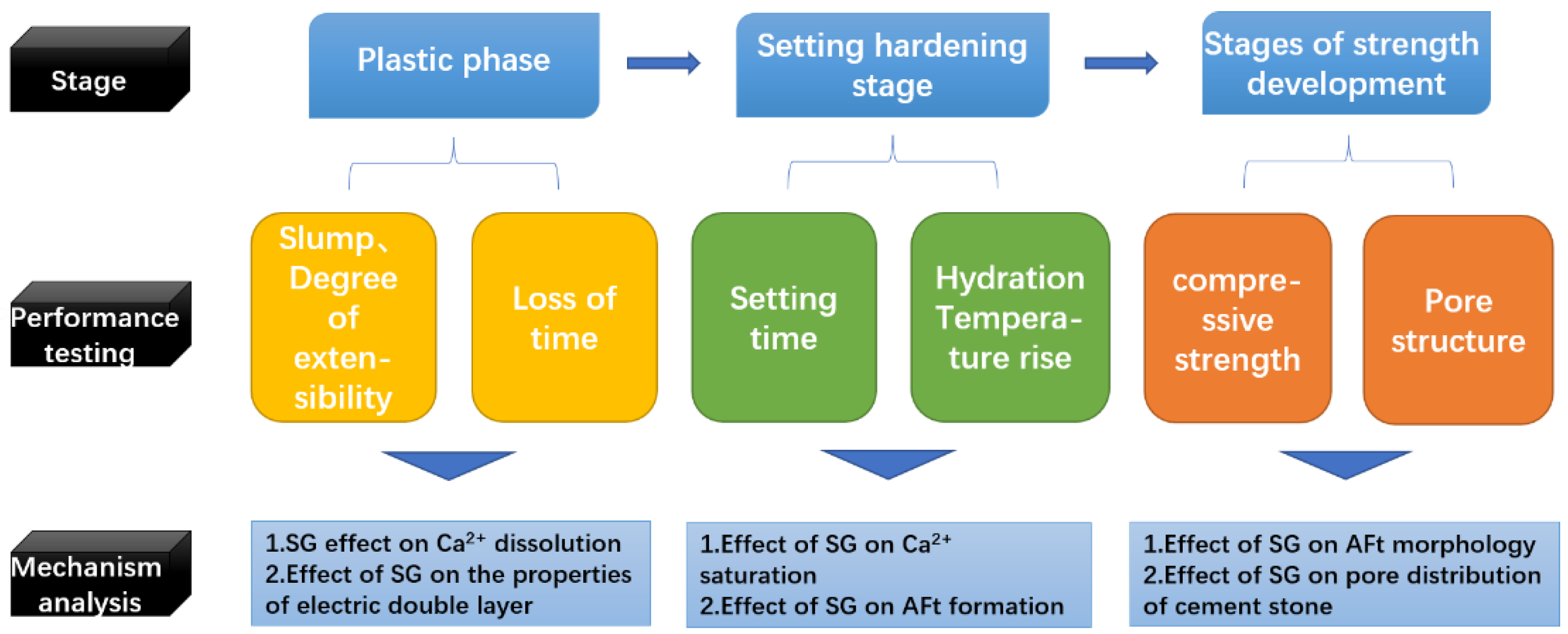

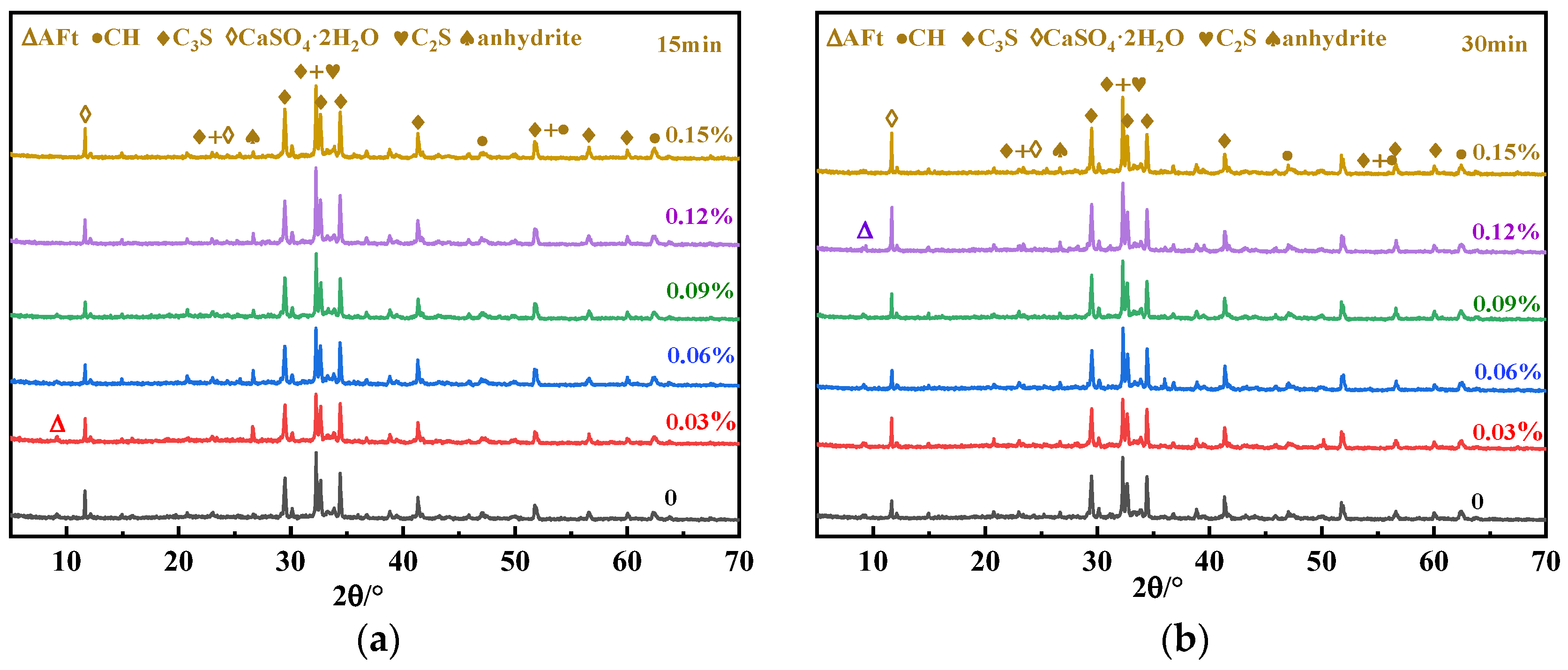

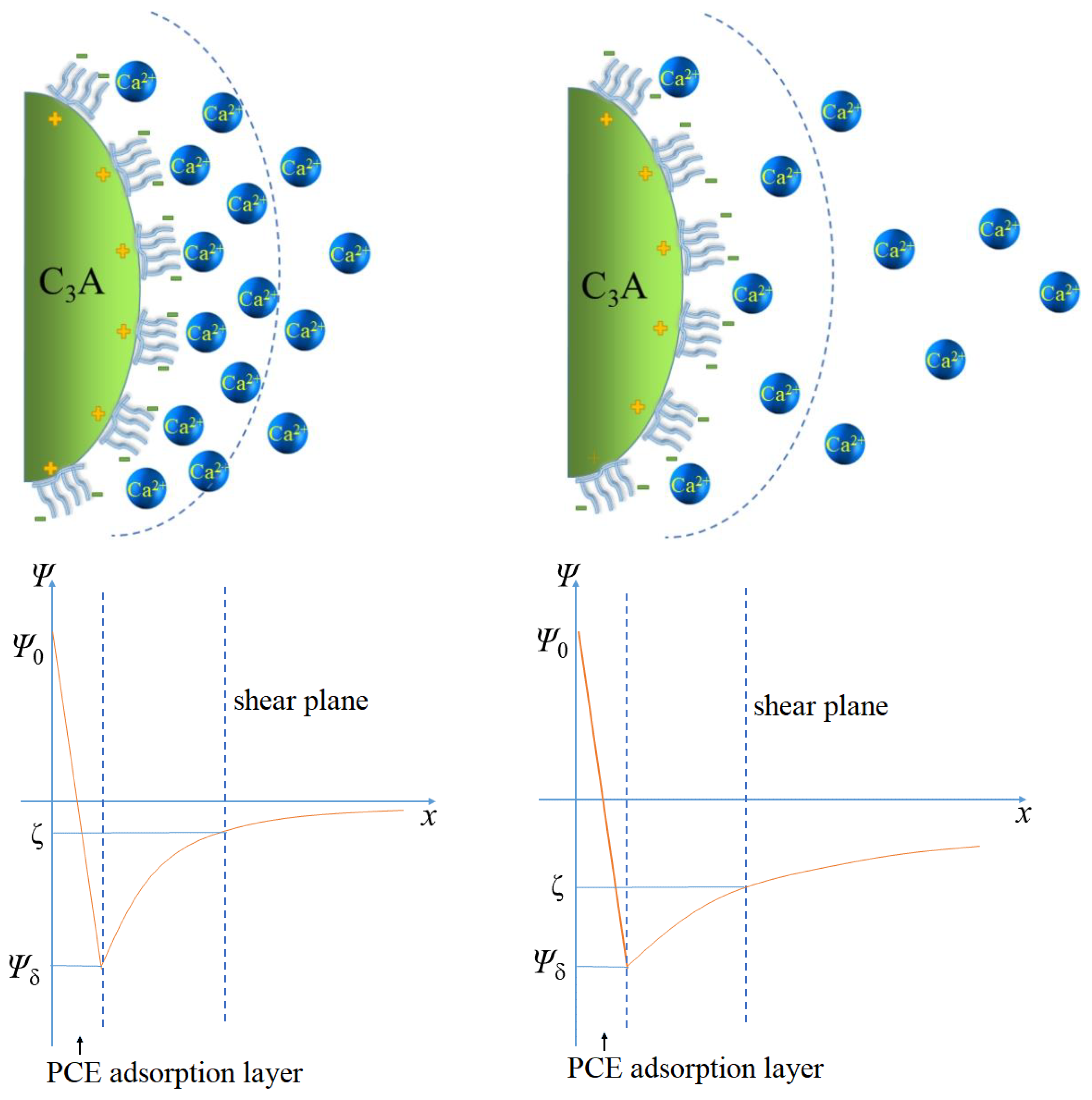
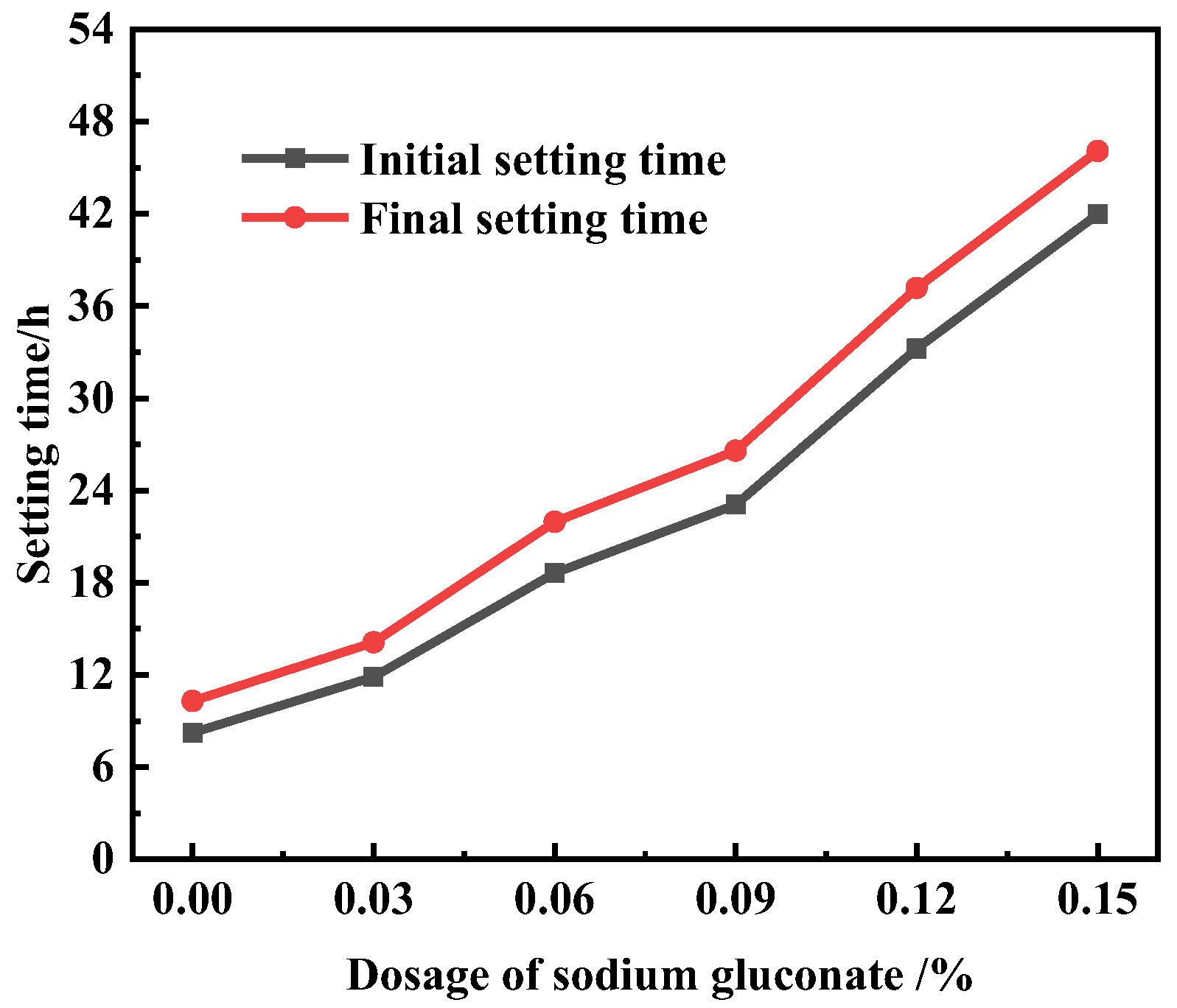
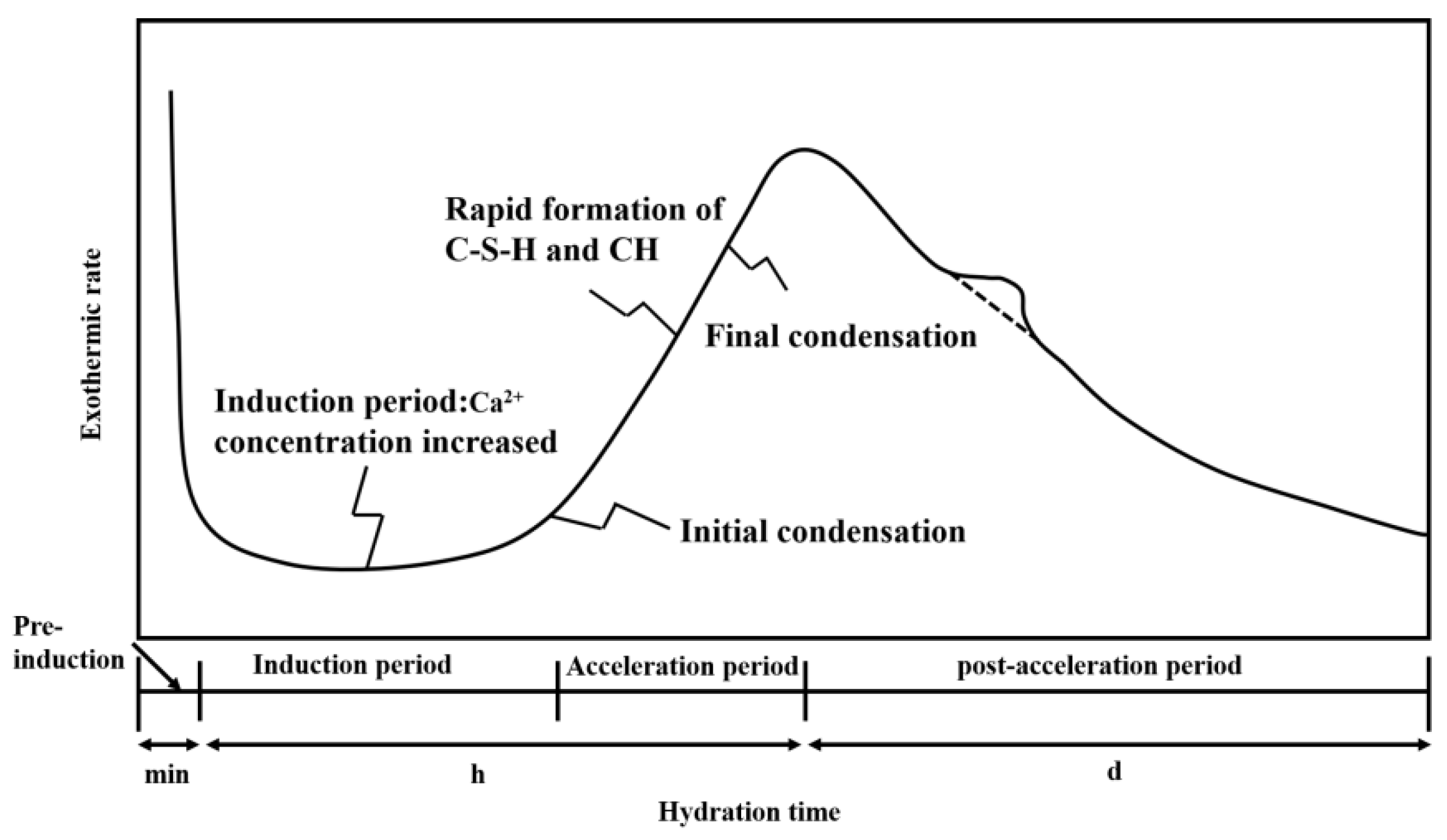
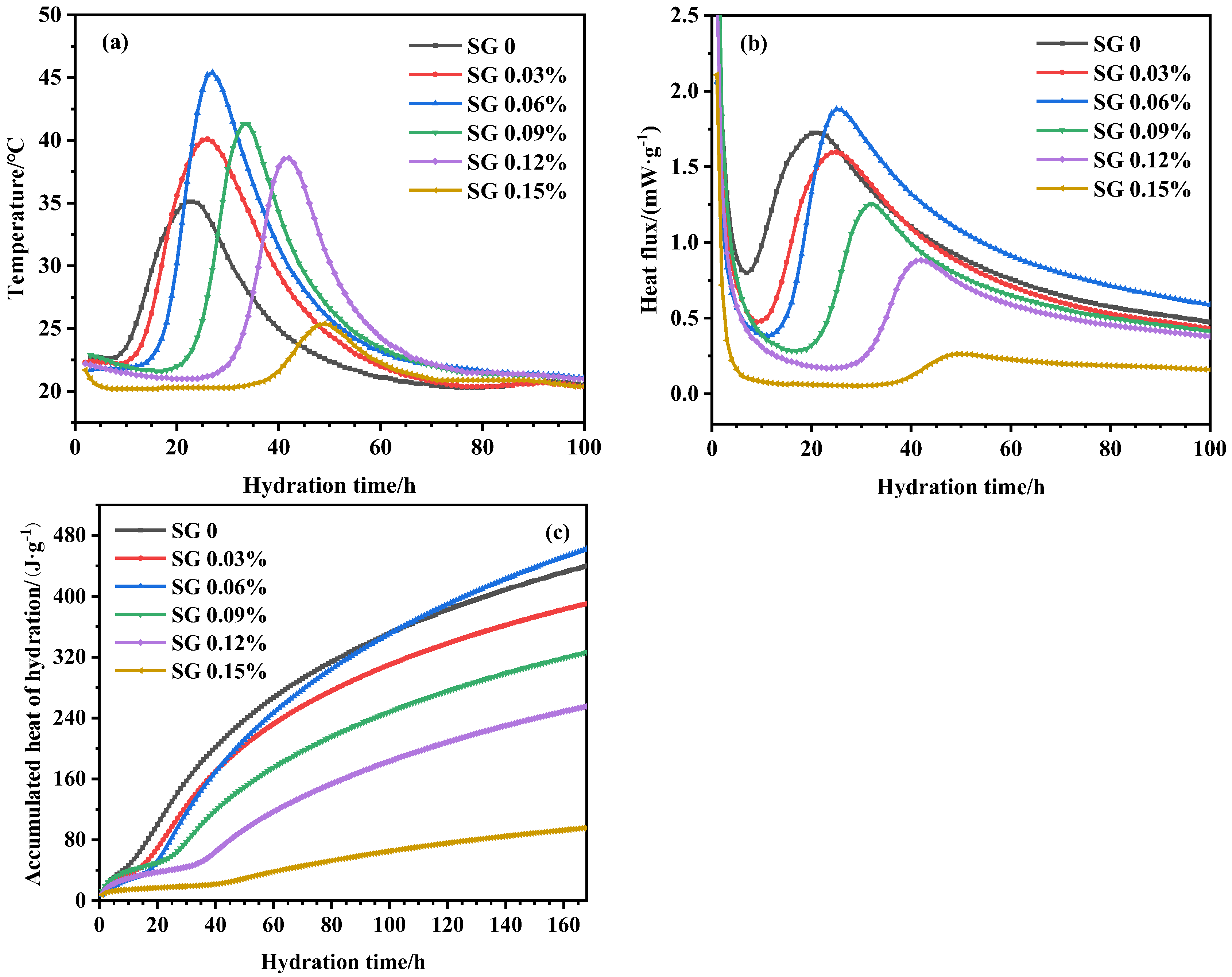

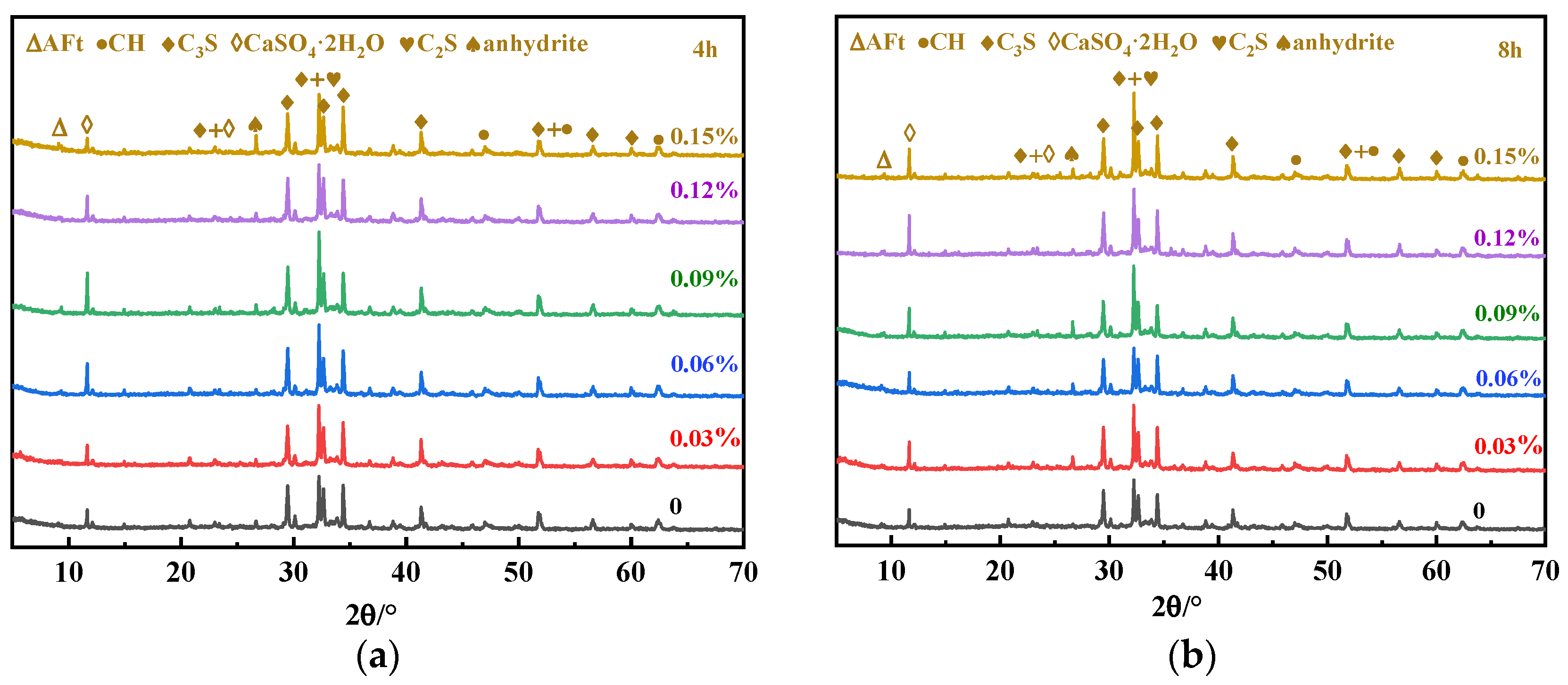
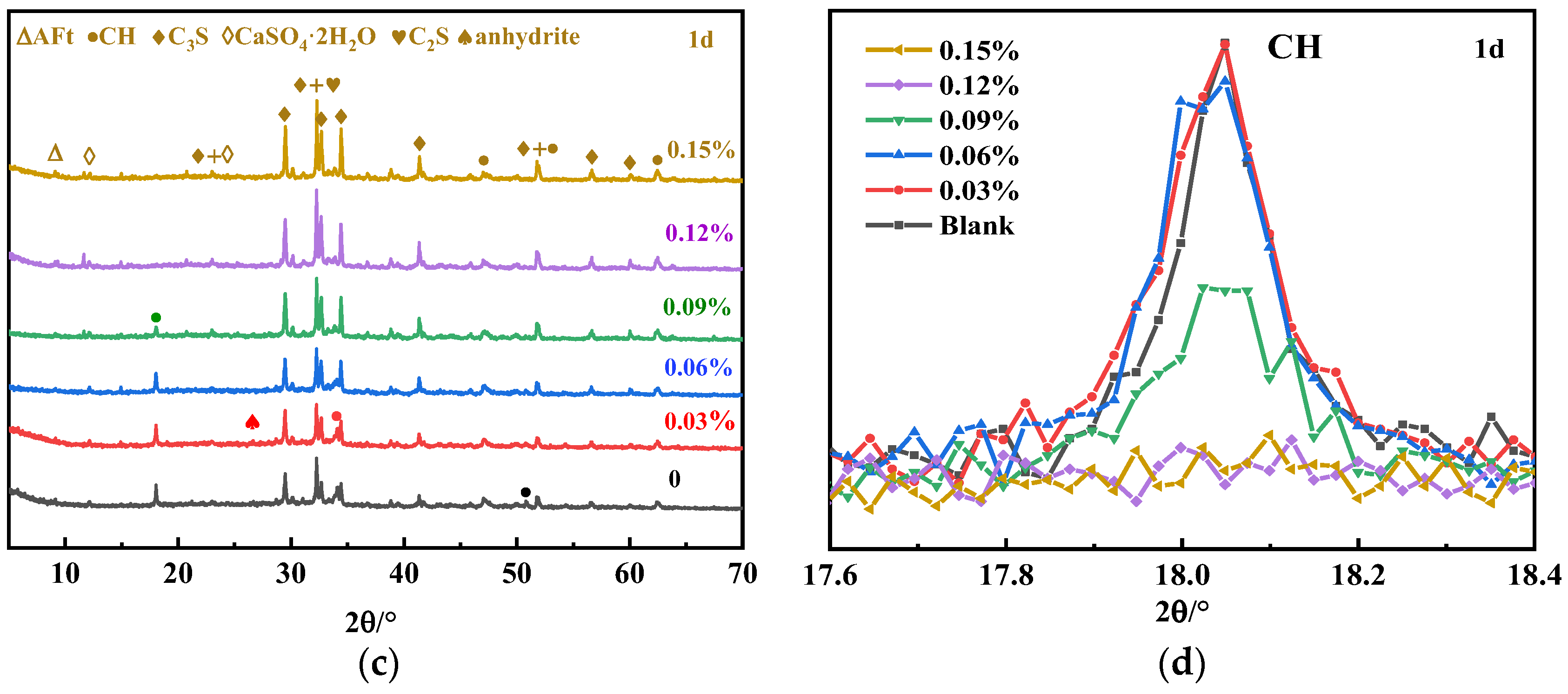
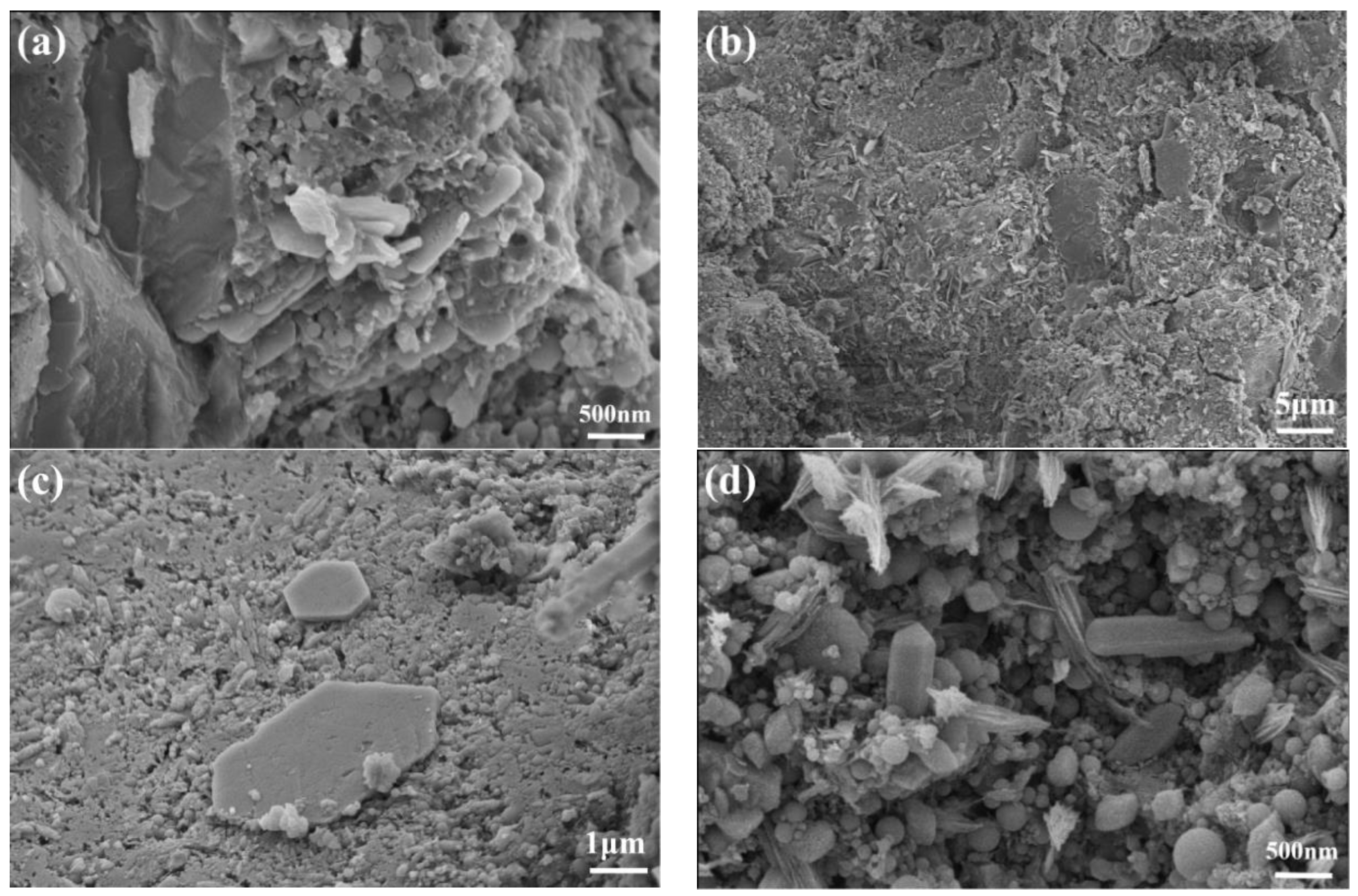
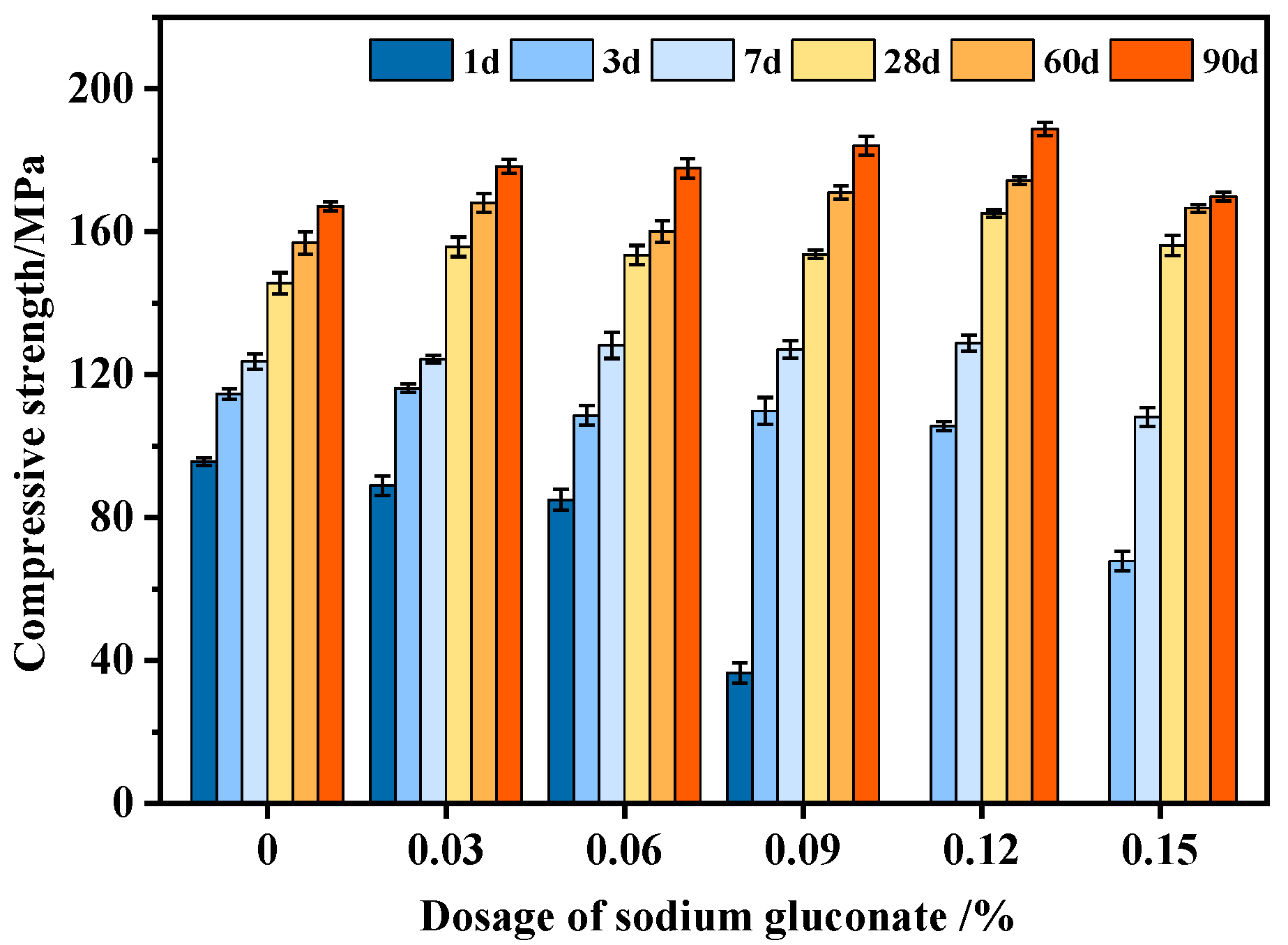
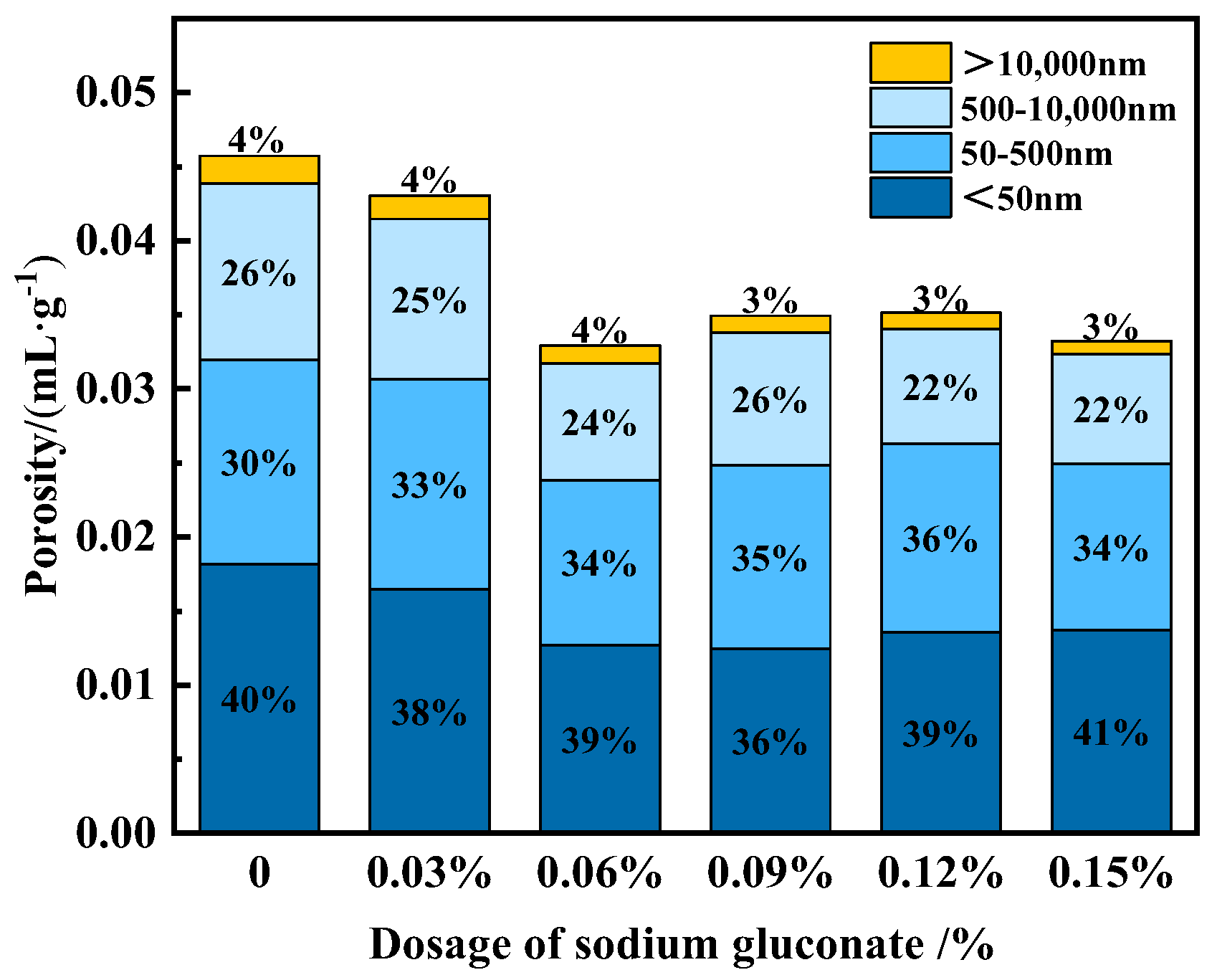
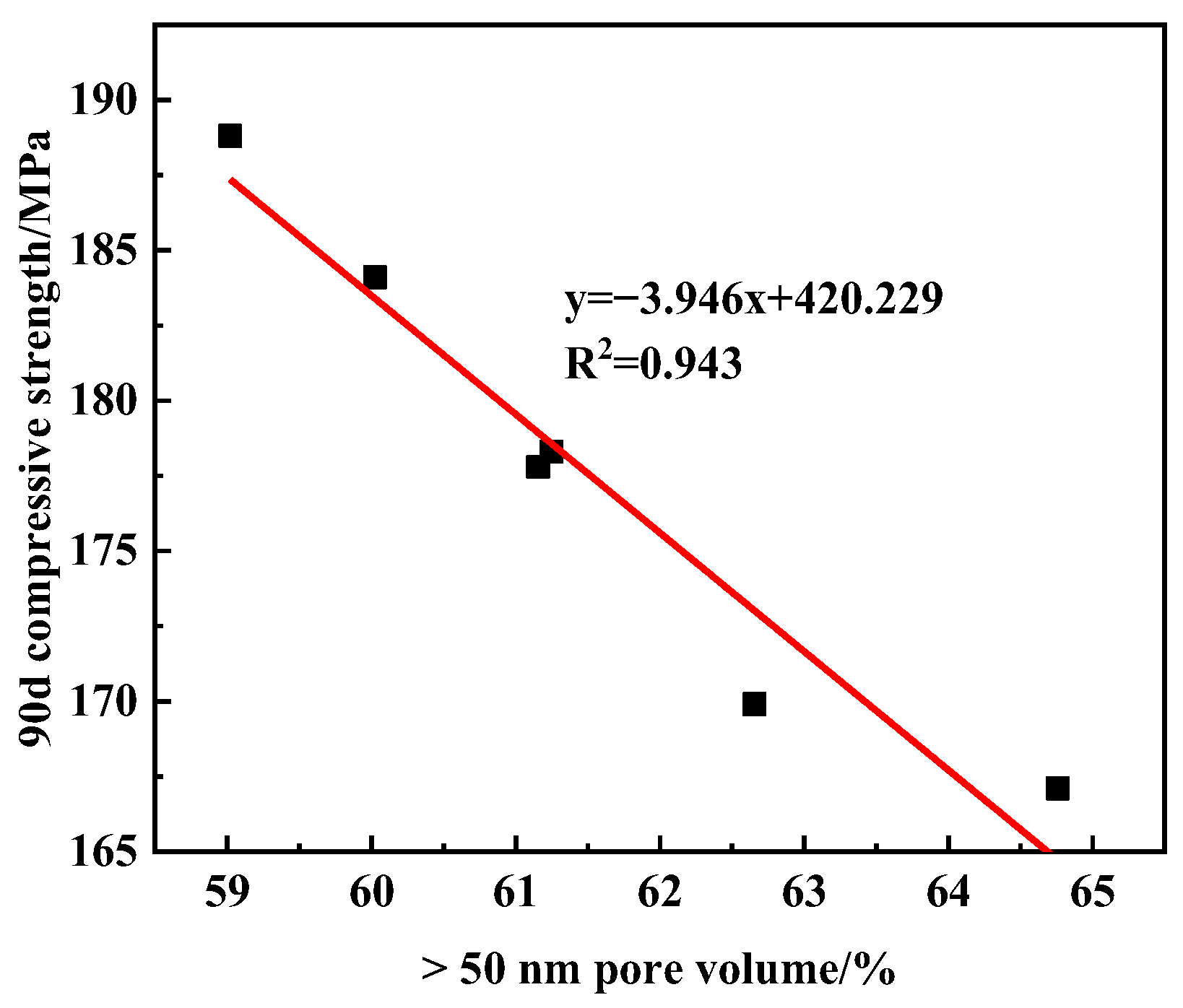
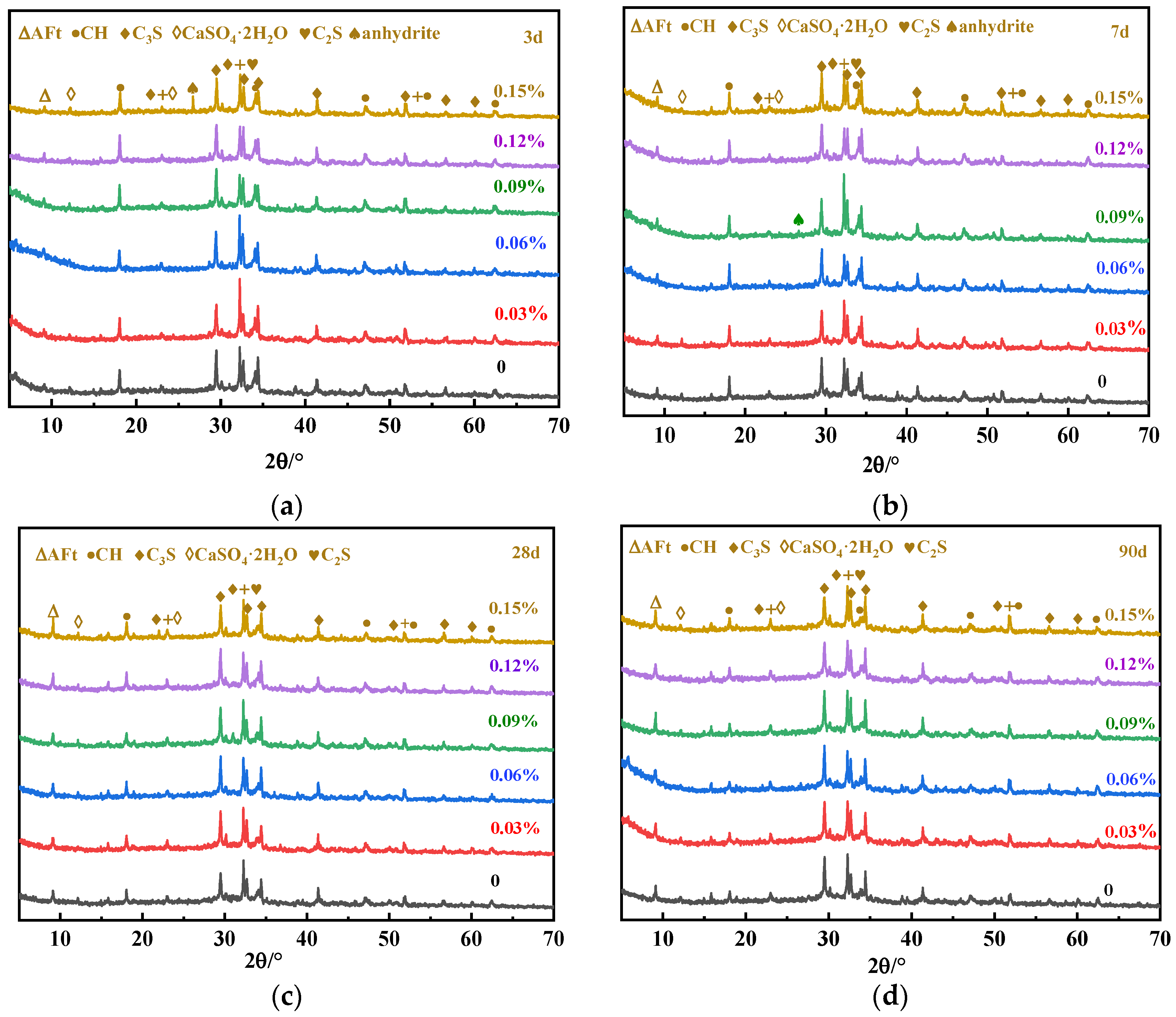

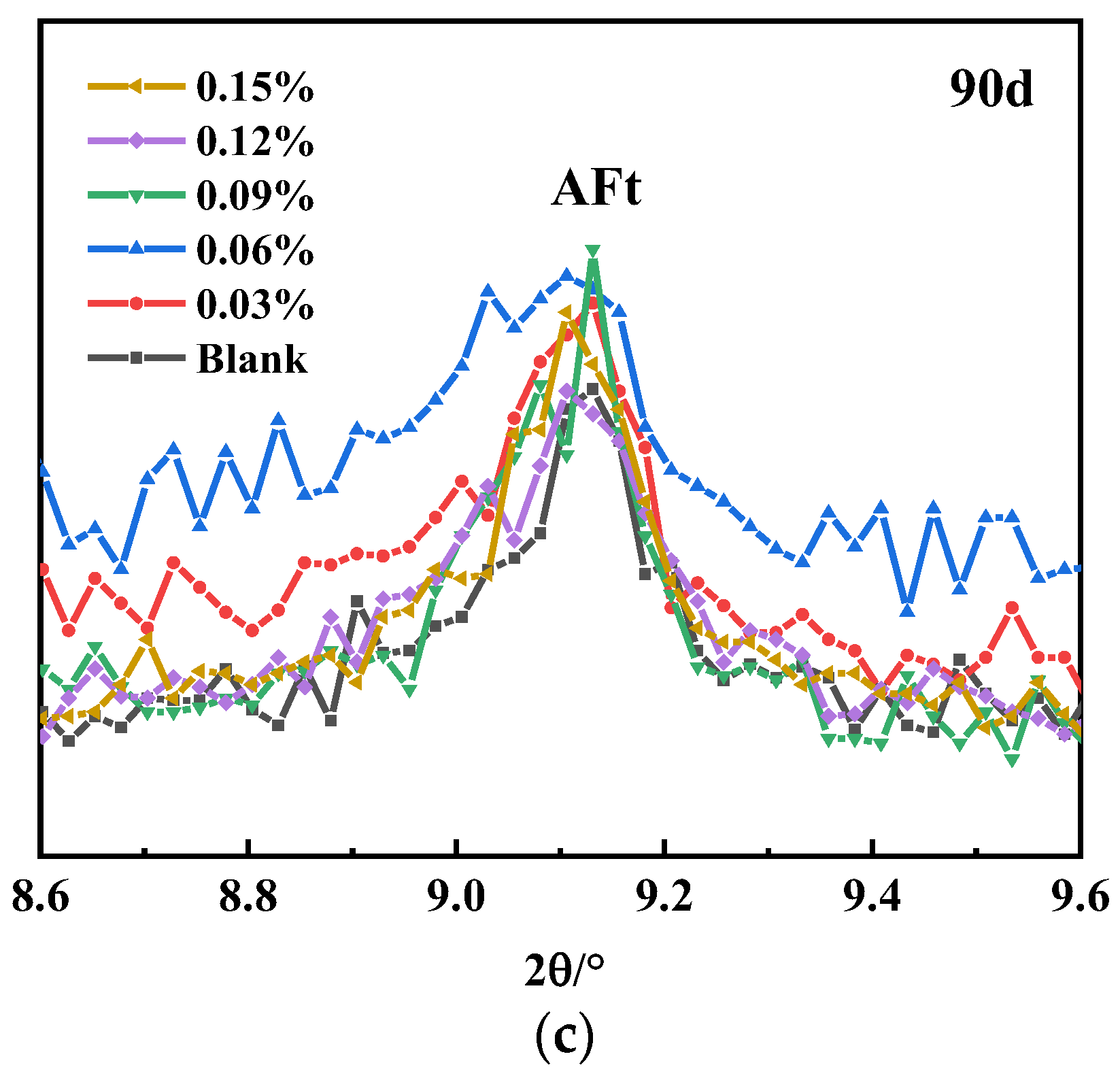

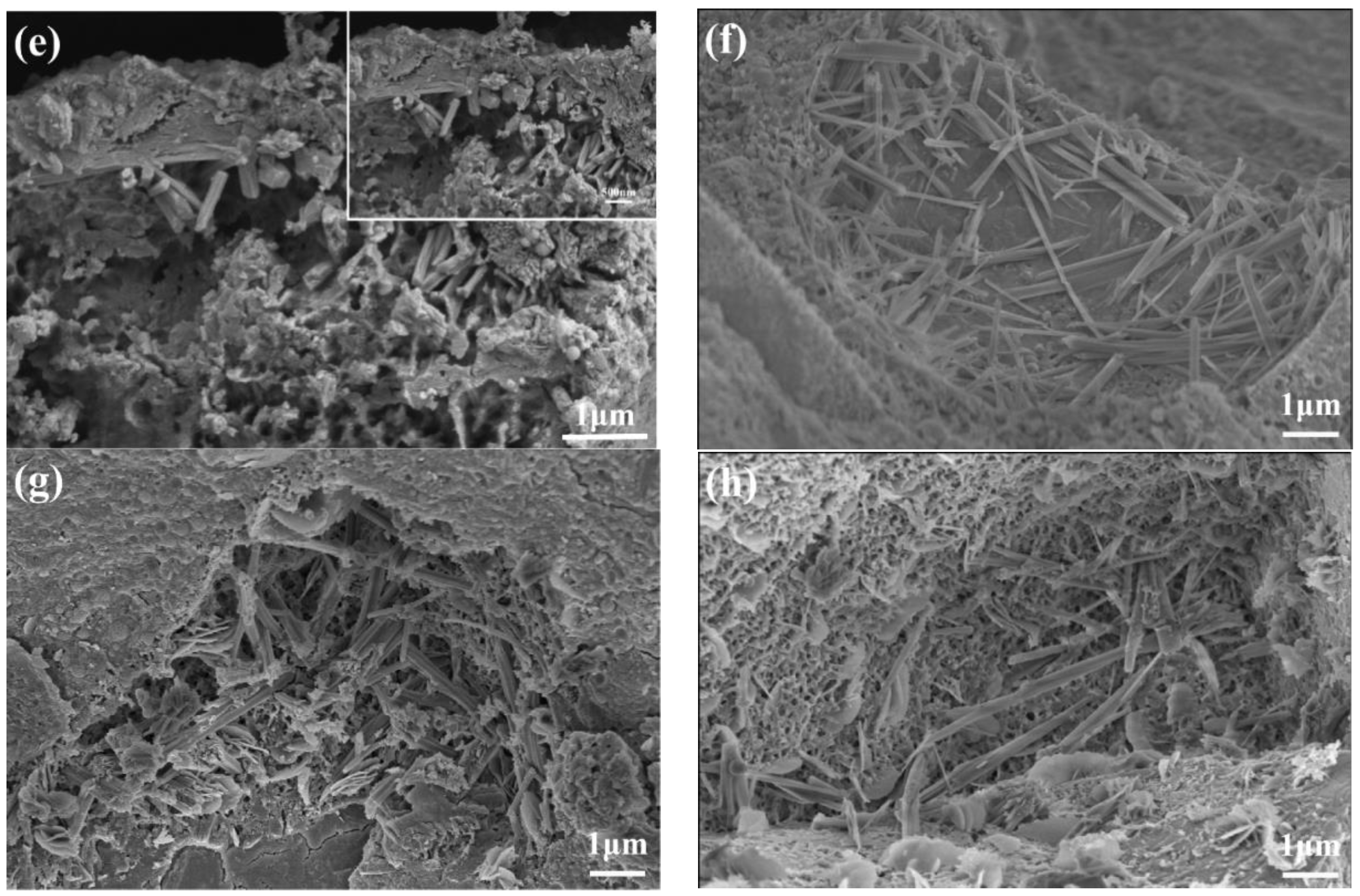

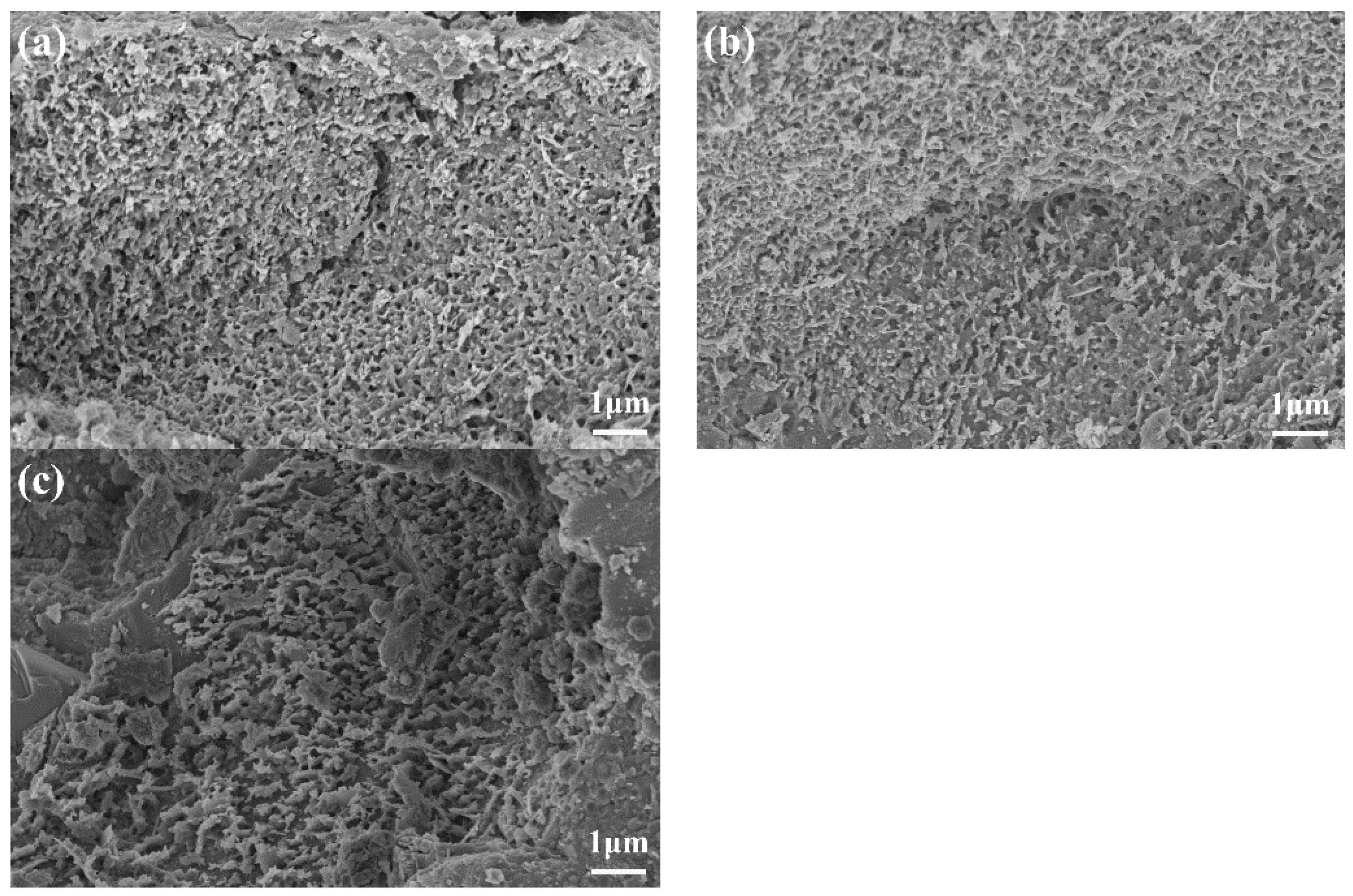
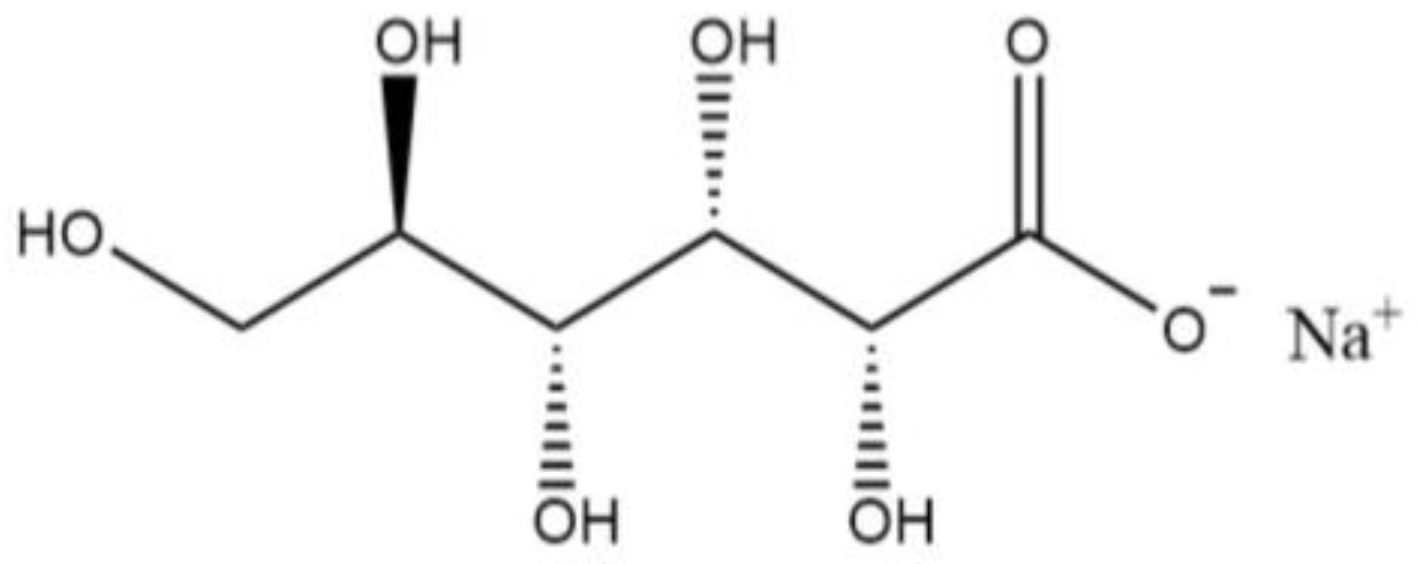
| CaO | SiO2 | SO3 | Fe2O3 | Al2O3 | MgO | K2O | Na2O | TiO2 | MnO | P2O5 | Sum |
|---|---|---|---|---|---|---|---|---|---|---|---|
| 67.67 | 17.12 | 4.24 | 4.15 | 3.06 | 1.73 | 0.732 | 0.399 | 0.254 | 0.0995 | 0.0824 | 99.54 |
| C3S | C2S | C3A | C4AF |
|---|---|---|---|
| 56.06 | 21.61 | 6.25 | 11.3 |
| SiO2 | SO3 | K2O | CaO | MgO | P2O5 | Na2O | Al2O3 | Fe2O3 | MnO | TiO2 | Sum |
|---|---|---|---|---|---|---|---|---|---|---|---|
| 96.68 | 0.873 | 0.701 | 0.489 | 0.448 | 0.327 | 0.127 | 0.126 | 0.0849 | 0.0063 | 0.0031 | 99.87 |
| Content of Cl− (%) | Specific Surface Area (m2·kg−1) | Water Content (%) | Loss (%) | Activation Index (%) | Density (kg·m−3) |
|---|---|---|---|---|---|
| 0.02 | 18991 | 0.94 | 3.13 | 115 | 310 |
| CaO | SiO2 | Al2O3 | MgO | SO3 | TiO2 | Na2O | K2O | Fe2O3 | MnO | P2O5 | Sum |
|---|---|---|---|---|---|---|---|---|---|---|---|
| 44.78 | 28.83 | 12.71 | 8.05 | 1.50 | 1.39 | 0.744 | 0.522 | 0.408 | 0.360 | 0.0194 | 99.31 |
| Al2O3 | SiO2 | Fe2O3 | CaO | MgO | K2O | Na2O | TiO2 | Loss (1025 °C) |
|---|---|---|---|---|---|---|---|---|
| 0.29 | 99.31 | 0.011 | 0.02 | 0.02 | 0.06 | <0.01 | 0.07 | 0.13 |
| Water-to-Binder Ratio | Cement (kg·m−3) | Silica Fume (kg·m−3) | Slag Powder (kg·m−3) | Quartz Sand (kg·m−3) | Coarse Aggregate (kg·m−3) | Steel Fiber (%) | SP (%) |
|---|---|---|---|---|---|---|---|
| 0.16 | 700 | 200 | 100 | 1000 | 400 | 2 | 3 |
Disclaimer/Publisher’s Note: The statements, opinions and data contained in all publications are solely those of the individual author(s) and contributor(s) and not of MDPI and/or the editor(s). MDPI and/or the editor(s) disclaim responsibility for any injury to people or property resulting from any ideas, methods, instructions or products referred to in the content. |
© 2023 by the authors. Licensee MDPI, Basel, Switzerland. This article is an open access article distributed under the terms and conditions of the Creative Commons Attribution (CC BY) license (https://creativecommons.org/licenses/by/4.0/).
Share and Cite
Wu, Y.; Yuan, Y.; Niu, M.; Kuang, Y. Effect of Sodium Gluconate on Properties and Microstructure of Ultra-High-Performance Concrete (UHPC). Materials 2023, 16, 3581. https://doi.org/10.3390/ma16093581
Wu Y, Yuan Y, Niu M, Kuang Y. Effect of Sodium Gluconate on Properties and Microstructure of Ultra-High-Performance Concrete (UHPC). Materials. 2023; 16(9):3581. https://doi.org/10.3390/ma16093581
Chicago/Turabian StyleWu, Yonghua, Yibing Yuan, Mengdie Niu, and Yufeng Kuang. 2023. "Effect of Sodium Gluconate on Properties and Microstructure of Ultra-High-Performance Concrete (UHPC)" Materials 16, no. 9: 3581. https://doi.org/10.3390/ma16093581
APA StyleWu, Y., Yuan, Y., Niu, M., & Kuang, Y. (2023). Effect of Sodium Gluconate on Properties and Microstructure of Ultra-High-Performance Concrete (UHPC). Materials, 16(9), 3581. https://doi.org/10.3390/ma16093581






